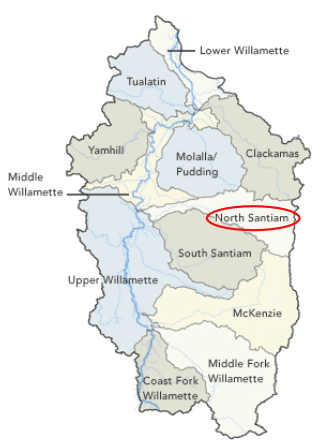What is a watershed?
 When we talk about a watershed on these pages, we’re referring to the land area drained by a river or stream.
When we talk about a watershed on these pages, we’re referring to the land area drained by a river or stream.
So a “watershed” can be the huge land area drained by the Columbia River or the area drained by the Willamette River. A watershed can be the 766 square miles drained by the North Santiam River or the few hundred acres drained by a small creek. Regardless of size, they all drain an area of land or “watershed.”
And just like that set of measuring cups you pull out when you’re getting ready to bake cookies, watersheds come in different sizes and just like the measures, they come nested, one in the other.
Take the examples I used. The Columbia River is the largest and the Willamette River flows into the Columbia at Portland. That means the Willamette River’s watershed is nested inside the Columbia River watershed, just like my ½ cup measure nests inside the full cup one.
Now here’s where the measuring cup example breaks down, because only a single ¼ cup measure nests inside the ½ cup one. But when it comes to watersheds, a bunch of smaller watersheds fit into the larger ones. For example, the North Santiam watershed is one of many component watersheds of the Willamette River’s watershed. In fact, each of the tributary rivers, streams and creeks that flow into the Willamette have a watershed that is nested in the larger Willamette River’s. So, a watershed can encompass millions of acres like the Columbia River Basin, or a few acres for a single small stream. They come nested, with more than one smaller watershed per pack.
Other terms used for watershed are drainage basin, catchment, catchment area, catchment basin, drainage area, river basin and water basin. To make things even more confusing, in the United Kingdom and Australia, a watershed refers to a divide or ridge that separates one watershed from another.
If you’re a little confused, don’t worry you’re in good company. Scientists have been trying to come up with one universally agreed on, reasonable, descriptive way to name and classify watersheds or for some time and haven’t really succeeded yet.
But let’s agree, at least here on our pages where we’re trying to make matters easy to talk about, we’ll use the terms basin and watershed interchangeably when we refer to the entire North Santiam drainage area. But we will use the term watershed, as in “the Mad Creek watershed” when we refer to the smaller component drainages of the North Santiam Basin. And we’ll name our watersheds for the creek or river that drains the area.
By the way, you can find out more about classifying and naming watersheds at: Wikipedia or from this document that explains the classification of watersheds and other hydrologic units that’s published by the US Department of Agriculture.

